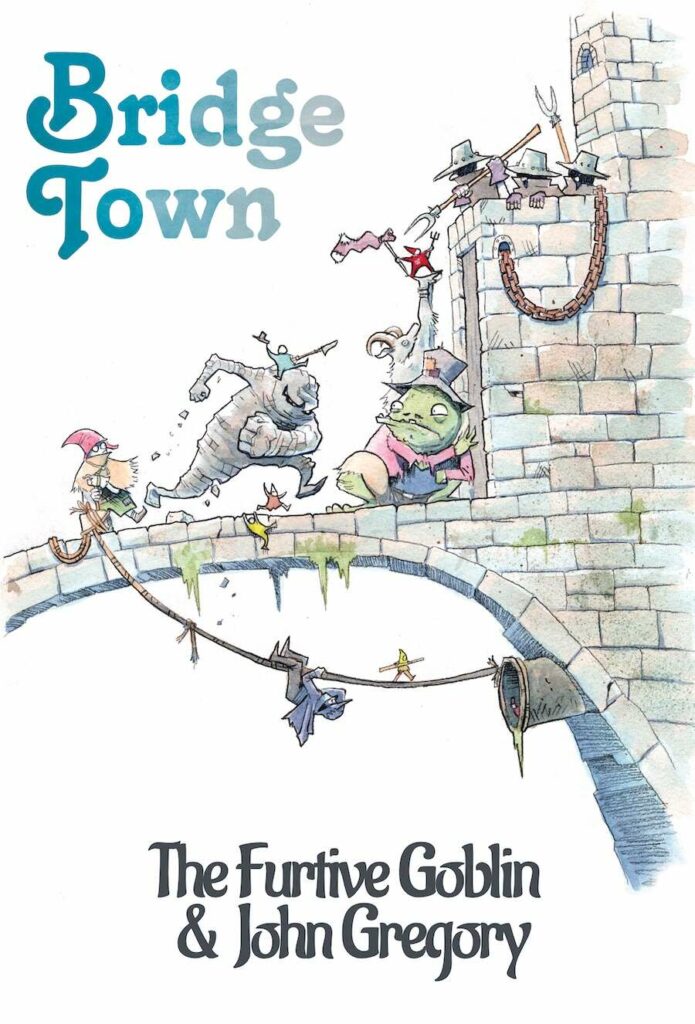Tag Archives: Gaming
Creator Spotlight | An Interview with Hankerin Ferinale of Runehammer about Crown and Skull

Fantasy RPGs are a dime a dozen, but Crown and Skull promises a refreshing experience. In this interview with Hankerin Ferinale, creator of the system from Runehammer, we delve into the unique mechanics, world-building, and design philosophy that sets Crown and Skull apart.
Ferinale sheds light on the inspiration behind the game, how it challenges player interaction with the world, and the exciting future planned for this evolving system. So, grab your dice, and prepare to be enthralled by the evocative world of The North Holds!

Crown and Skull feels like a fresh take on fantasy RPGs. What inspired you to create this unique system?
I played Fantasy Hero (1st Edition) for years in high school. The system didn’t age terribly well, but its foundational thinking was great. After 8 years of RPG publishing, I wanted to both look back to my origins and forward to a few current inspirations like Cairn and Into the Odd. That’s just the mechanics. The WORLD and TONE are where I’m the most excited. I’ve been working as a writer and artist for over three decades now, and I started to feel real, emotional, moody, evocative stirrings in this setting. I hope all the readers feel as deeply connected to THE NORTH HOLDS as I do. That humanist connection is teh core inspiration of the book(s).
The “skill as tool” approach sounds intriguing. Can you elaborate on how this changes player character interaction with the world?
For ages now, we’ve been taught that our stats/attributes can solve any problem with a die roll in role playing. Removing stats from the mechanics and being strict above the use of skills only, forbidding attempts by the unskilled altogether, is the biggest step toward substantive character differentiation I have seen. So different, in fact, I find many players and GMs a bit dazed at first, then very excited. As for interaction with the world, there’s far more think-before-act. The player can’t simply roll a stat to get out of a bind or overcome a challenge.
The phase-based combat seems like a strategic twist. How did you develop this system and what are its advantages for players and GMs?
I didn’t! I reduced Fantasy Hero’s 12-phase system into a 5 phase setup. The advantage is almost entirely offered to the GM. These 5 phases allow room to build truly challenging foes against even large parties of heroes. A single foe might take action(s) on up to 3 phases, while heroes are always limited to one. This lets the monsters expand into vastly larger realms of challenge and variety, compared to traditional initiative systems.

Crown and Skull is known for its emphasis on player skill over character stats. Can you talk about the design philosophy behind this approach?
As mentioned above, stats blend all characters together. By removing them entirely, and forbidding attempts by the unskilled, the differences between heroes becomes extreme. MUSCLE is a skill, not a stat. No muscle skill? You can;t even ATTEMPT to move the boulder. This differentiation enhances one of the key visions of the hobby’s framers: that characters need each other to thrive.
We’ve seen some discussions about the lack of traditional “gold” mechanics. How does Crown and Skull handle character progression and rewards?
In CROWN, you earn hero points. Gold is seen as banal and uninteresting, though present if your table wishes. Hero points replace gold, and adjudicate the finding of usable loot. They come in all kinds of reard packages, from deeds of renown, to the dire and unavoidable choice of THE CROWN, OR THE SKULL?

Crown and Skull is still evolving. What are some exciting things you have planned for the future of the system?
There are 4 more volumes of CROWN and SKULL coming. These volumes introduce new mechanics, world material, and tables. The coolest part of the forthcoming volumes, though, is portraying ongoing epochs of the world, influenced and shaped by the actions of all of CROWN’s players and GMs. It is a 6 year experiment in a truly living world… another core dream of our hobby’s mighty originators. Achieving a truly living world is not easy! It requires a DAILY interaction habit with the player community.
Do you have any advice for GMs and players who are new to Crown and Skull?
Join the Runehammer Discord! This isn’t a sales pitch at all, but a call to engage with a living, breathing community that is building a world brick by brick. It’s also a great resource for those odd questions or sticking points as many 5E players seek new horizons.
Thanks for the interview, Obsidian! FOR THE CROWN!
-Hankerin Ferinale

Crown and Skull is produced and published by Runehammer. Visit them on social media:
Patreon, Youtube, Instagram, X (formerly Twitter), Facebook
Obsidian Portal Campaign of the Month April 2024: Season of Strife

Twenty years after the fall of Utugash’s kingdom, a group of adventurers sail into Celestine and into their new destiny. Villains and allies of every faction eagerly await to use the newcomers for their own purposes, while even more sinister forces lurk in the shadows… Join us in talking with GM EdgarS as we explore the Season of Strife!
First off, feel free to tell us about the person behind the GM screen. Where are you from? What do you do aside from gaming? Alter Egos? Life partners? Family? Where can we interact with you on the internet?
Heya, I’m Edgar, I’m from the Netherlands, and I’ve been playing D&D for about 15 years now since I was invited to join a campaign for the first time. I really got into Critical Role around 2018 and watching it helped elevate my gaming and give me a way bigger sense of the possibilities the medium held to tell a story beyond ‘there’s a monster in the next room of the dungeon, go hit it.’ I also started DMing in 2018 and have or are running a couple of campaigns at the same time.
Before D&D I came from the world of tabletop gaming: building, painting and playing Warhammer Fantasy and 40K mostly, which really helped me get out of my shell as a teen (you gotta play with/against other people physically present on the other side of the table after all). From there it was a hop and a skip to D&D. I’ve been lucky to have had a pretty stable and dull life. The most I have in terms of baggage is experiencing bullying in high school because, well, huge giant nerd, but it’s precisely due to things like tabletop gaming and DMing I’ve gotten over that and grew to be a version of myself I enjoy, and being way more extrovert and bringing the sorely needed levity at office meetings. But yeah aside from that, I grew up in a fairly affluent household with loving parents, went to college (studied history and international relations), and after maybe a couple of years in the wilderness got a proper job recently working for the government. I even bought my first apartment a few months ago, which gave me the opportunity to set up a purposely-built storage room for all of my D&D terrain!

As for online, I used to be more active in various places such as tabletop gaming forums, but now I mostly lurk in peace and quiet, stay in my lane, and occasionally tweet out some art or dnd pics on my twitter (no I’m not calling it X) at @DCabbagefarm. That refers to Emperor Diocletian’s cabbages by the way. I’m a historian. Hi.
Tell us about “Season of Strife” in a nutshell. How did you design the world? What was your inspiration?
So the Season of Strife was born when one of the players put out a ‘looking for group’ call on Tumblr for an online d&d campaign, and I decided to take the plunge and offered to DM, back in late 2020. Not quite knowing whether this’d end up being a massive campaign or would bleed out early I decided to use the same homebrew setting I was using for my weekly campaign, the Twilight of the Spheres (and by the way, that one’s got its own Obsidian wiki too, probably even more expansive than the Strife one), but simply designing a new area for the world like it was some kind of Warcraft expansion. Exactly how many hidden continents are there?!
After this I expanded the map further, filling it out as I went until it reached its current state of completion, with enough space for a few more fresh campaigns. Here’s the full map, and be warned it’s a big boy

The first Twilight of the Spheres campaign (2019-2022) took place in the north-eastern region of the world, Eos, dominated by the Coalition (a pretty standard late-medieval European fantasy society consisting of a union of city states) and the Kyshtar Dominion (a majority dragonborn proto-industrial semi-Babylonian hodgepodge). That quarter of the map was all that existed of the setting, with no more than vague allusions to other stuff being beyond the boundaries. The new area I added specially for the Season of Strife was far to the south of it, an island chain called the Teylu Archipelago, inhabited by the Teylu eladrin & water genasi people who mix inspiration from both Polynesian culture and aesthetic, and Scandinavian and celtic. Two of the players are Scandinavian so that’s how that got included into the mix, plus the traditional celtic influences of the Feywild re: the eladrin. As a historian I like to draw heavily on history as inspiration for my worldbuilding, and regions in my setting often have some kind of ethnic or socio-political conflict. In this case it’s the colonial settlers who arrived from the Coalition and Kyshtar Dominion (collectively called ‘the Elyzians’) in the wake of a devastating flood that hit the Archipelago, and whose presence is pushing the Teylu to the margins. This conflict operates as a backdrop to everything going on in the campaign and it’s been very fortuitous that the players themselves chose to have a party consisting of two Elyzian characters and one from the Teylu, so that they could RP through these clashing perspectives and get a multifaceted view of the situation. Settler politics. Fun!
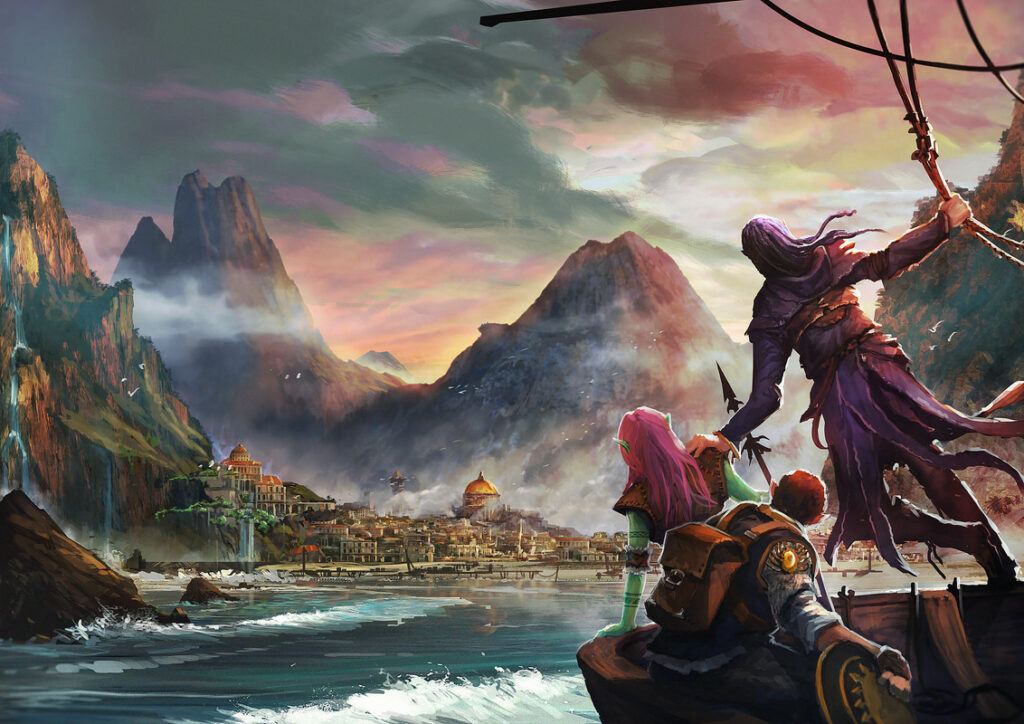
As for the outline of the campaign’s plot, in ancient times the Spring Court of the Feywild was cursed by the other season courts to slumber, and left behind buried in the material plane. However now a radical Teylu cult, the Teyhua, are seeking to awaken Spring and use its power to expel the settlers from the Archipelago. To do this a number of seals first need to be removed, which can each only be done by the Summer, Autumn, Winter and Spring knight (mortals in the employ of the courts as their champion, because they’re able to break Fey rules such as crossing running water and being able to lie), and the player characters find themselves entangled within this storied web and – mostly by accident – becoming knights for the fey courts.

I’m an avid worldbuilder, drawing heavily on historical minutiae, so in order to scratch that itch and build up a corpus of material I also write a “worldbuilder gazette” article every few months, dealing with info about the world that might not naturally pop up during sessions, such as how the different regional calendars work, lunar orbits, holidays, the economy, and nations the players haven’t visited yet. For every other worldbuilding-obsessed DM out there: I see you, I hear you.
How regularly do you play, and where do you play? Tell us about your current group of players.
The campaign is played online, using roll20 and Zoom, and we play about once every two to three weeks. With me included we’re a group of four from across the UK and west-central Europe. I’m gonna refrain from telling you too many personal details, but I’ll just say they’re some of the goshdarndamndest best RP’ers – nay, actors! – I’ve ever seen at any D&D table. They’re so insanely good. Sometimes I just shut up and listen for 30 minutes while they RP amongst themselves.
You put a lot of emphasis on the factions in your game, enough to place them on the front page. Can you tell us how important they are in your game?
As mentioned previously, I draw a great deal from history when worldbuilding, and if anything history is a revolving door of peoples, polities and cultures clashing with each other. The factions on the wiki’s home page are for the most part the main cultural groupings; what background an npc is from can inform a massive amount about their character, customs and perspective on things, especially how they relate to the local background conflict and what that means for their relationship with the player characters. I don’t want to have my game world populated by unattached caricatures, I want the npcs to have allegiances of their own – be they culture, country, ethnicity, etcetera. In my opinion they make characters richer and more vibrant, and give the players an additional set of approaches to relate to them (are they from a rival faction? Are they both foreigners away from home? Do they have certain proclivities or interests relating to their culture that might be used to sway them?)
I don’t want every country to be contained in its own cordoned-off little box either, like they’re in their own stasis bubble: People move! Countries do war, trade, diplomacy, propaganda, cultural exchanges, religious exchanges, espionage, migration and more! Interactions between the different factions are the building blocks of my world, and the quest design flows organically from that. Part of having a reusable setting is having background conflicts that continue to passively generate animosity that can be leveraged into new quests. In the season of strife campaign the main plot is almost entirely motivated and impacted by the background conflict of the indigenous Teylu being squeezed by the Elyzian settlers, and most quests and npcs are at the very least tangentially related to that. Most recently the players were sent on a little sidequest to solve a dispute on some Teylu islands where wealthy Elyzian settlers had built… well… the Hamptons, basically, and their mayor was secretly throwing meat into the bay to lure sharkfolk to the local Teylu water genasi village’s spiritual site to disrupt their traditional links to the land.
I’ve also been working with a couple of artists whom I have commissioned many times. One of them is designing the factions icons for me. Those icons are all unique and purpose-made for my setting, not just plucked from the web! The faction icons there are the ones that are currently done, but in the end there will be two to three times as many! I’ve currently got a plan in the works to start a project with these artists, in order to make an illustration of one or two “average joe”’s from each main culture, to create a kind of setting sourcebook and give an idea of what the regular person in the street of each nation would look like.
Your WIKI section is very detailed and quite comprehensive. Who is responsible for adding the information and organizing it? How much time do you spend updating it as the campaign progresses?

Your WIKI section is very detailed and quite comprehensive. Who is responsible for adding the information and organizing it? How much time do you spend updating it as the campaign progresses?
L’wiki, c’est moi. It’s all done by me and I’ll conservatively estimate “a metric ton of time”. It’s a good thing I enjoy wiki-building (I read aloud from my hostage note) and I’m a glutton for punishment if nothing else. My players do help me out every so often with writing sections of the summaries if I don’t have enough time to finish them, and one of my players performs vitally important recording wizardry, making video recordings of the session and uploading them to a private youtube playlist so we can watch them back and use them to make summaries. And she also makes thumbnails for each session! Recently we also redistributed some tasks so that another player would help me out with writing the short synopses.
Your campaign has many items and makes great use of Obsidian Portal’s Items section. How do you feel the extra work it takes to implement this benefits you and/or your players?
It’s always good to have a central place to store data as a master reference. Handing out item cards or putting them into word documents or reading out the item descriptions is all well and good but you can almost guarantee that stuff’s gonna get lost or misplaced at some point. Much better to have somewhere you can always refer back to. We also have a few items that have become real staples of the characters’ iconic look, such as the sword Spring’s Edge, one of the first items the group acquired in the first ten sessions, and it’s nice to be able to give these items an image to represent them.
What made you choose D&D 5e as your gaming system? Have you played other gaming systems, or earlier editions? How do you feel it compares?
I played 3.5th edition in the first campaign I joined (playing for a good 13-14 years) and DM’ed it for a while, and gods above and below in hindsight I found it so cumbersome and bloated, with hundreds of sourcebooks and a level of stat block number crunching I was simply never going to be able to get a proper grip on; After a while you get monsters on the field with modifiers of +20 to hit, and if you overshot the challenge rating you were supposed to give the players by a bit you could quickly end up with foes the characters could literally do barely more than single digit damage to. And worse, I disliked how lower level spells became exponentially useless as time wore on, because both the DCs and effects of those spells remained as low as a low level character casting them, encouraging you to only throw your highest level stuff. I could probably go on for a while but I’ll save the internet the byte space.
In comparison the 5th edition rules are easy enough to follow that I learned them simply through watching/listening to Critical Role, picking up most of the game (and learning answers to some of the baked-in rules conflicts or less commonly understood features) before ever even opening the Player’s Handbook. The familiarity I now have with the system appeals to me, the basics are pretty easy to follow, flexible enough to homebrew off of, and combat can be balanced quite decently on sheer ‘vibes’ alone, while fixing a lot of the annoyances I had with 3.5 (I don’t think any annoyed me more than being unable to move more than 5ft and make more than one melee attack, turning most battles into stationary ones because it was actively detrimental to move). The system is also robust enough that you can overshoot and make monsters too strong, without instantly signing the players’ death warrant.
How much time is usually spent preparing your game sessions? Describe a typical session.
Most sessions take me a couple hours of prep, often about equal or slightly less than total playtime… except when I need to build a battlemap in Roll20, which can eat up hours of my time while I finetune tiny details. Regardless, my prep can often be described as “leapfrogging.” Whenever I prep a session I will inevitably have enough material that we end up covering (nearly) two sessions with it. Plus if I need to buy time, I’ll just let the player characters talk to one another. Bam, there’s half an hour filled, easy peasy. In our very latest session the players started right after having been portalled to the gates of a Feywild city. They were right in front of the gates! It took 30 minutes before they even walked up to the guards! It’s a miracle we get anywhere at all.
Can you please explain the difference between your session summaries and your miniature session summaries? What is the difference between the two types of sessions?
Those both relate to the same sessions. The ‘session summaries’ are the long versions – which are probably a little too long at times, sometimes reaching more than 10 pages and rarely less than 4 – and the ‘miniature session summaries’ are brief synopses about one paragraph long. It’s a practice I picked up in the first campaign that I ran, where I noticed players had difficulty recalling the basic outline of the few sessions before it (especially because that campaign only played once every 6-7 weeks or so), so the mini summary contains a very basic outline of the main events/facts of the session, just so you can more easily search back for when something happened and so you can recall the basics at a single glance, rather than walls and walls of text. The mini summary section on our wiki then links to the long-form summary of that particular session.

I’m a bit of a fanatic about chronicling everything in massive detail because:
A) I’m a historian and work with archival departments at a government ministry. It’s kinda in my blood at this point.
B) The first campaign I ever joined as a player ran for like 12-13 years and we had basically zero documentation, so halfway through there were just complete year-long arcs of the campaign I had no recollection of or where I didn’t know the order of events anymore, so a lot of plot stuff inadvertently flew over our heads half the time because we didn’t remember anything.
C) I just can’t stop myself. Help.
How long have you been using Obsidian Portal? What brought you to the site and what keeps bringing you back?
I had an account before then but I’ve actively used Obsidian Portal since about 2018, when I first started DM’ing my own campaigns. There might be shinier things out there, with widgets and gadgets and holograms, but I like the easy legibility Obsidian Portal’s format provides if you wanna put up big blocks of text. With some pretty basic coding you can do a fair amount to make it look nice, formatting it like it’s a Wikipedia article. And of course being able to hyperlink back and forth between different pages makes navigating through the wiki a breeze.
If you had to pick just one thing, what would you say Obsidian Portal helps you with the most?
I put up stupid amounts of text, and like I said above I like the legibility Obsidian provides. As a history enthusiast my favored terrain is wikipedia pages (I get a +2 to hit modifier against other historians), so that’s the model I like to copy. I’m also happy with the pre-defined sections for characters, game logs and items, rather than needing to build custom wiki pages for each of them and it becoming a right old mess. If there’s anything else I might want to see from Obsidian Portal it’s one or two more sections like that, such as a bestiary section for common creatures/creature types found in your setting.
What would you say is the biggest highlight of your game so far?

Oh gosh, oh golly, oh jeepers, I had such a tough time answering this question!! We’ve played 74 sessions up to this point, and so many exciting things have happened! Should I pick the time the cleric held an impassioned speech before the church to denounce the bigoted high priestess? Or the victory in the Autumn Tournament when the rogue defeated the other candidates to become the new Autumn Knight? Perhaps I ought to pick that time the party were surrounded by enemies on all sides and opened up the Iron Flask they’d carried with them for nearly 30 sessions without knowing what was inside, summoning a succubus to their aid? That time the ranger/druid had a romantic ride across the meadows of the Feywild on the back of a stag with one of the main villains (he’s hot so it’s okay), or simply when two players were wasted drunk and trying to escape across the rooftops from some bandits, with the air genasi rogue floating away from danger like a balloon?
This artist has done a huge series of illustrations for our campaign, all of which can be found here
I guess if there is one moment I had to pick it would be in the earlier stages of the campaign when the players were at a fancy gala, and the rogue suddenly ran into the crime boss (and secret weretiger) on the dancefloor whom she’d been romancing at the start of the campaign before getting cold feet and breaking it off. I cannot describe the utter mic drop moment when that French accent suddenly returned and I showed off the art I had commissioned for the occasion:

As an aside I also want to add that for me the personal highlight of any game is when the ranger/druid communicates with any flora or fauna. I never know what voice will come out of my mouth but let’s just say the interactions don’t really live up to the wise, sage druid image. Pigeons hate her, seagulls have died for her, trees want to practice their stand-up comedy routines on her.
Okay, as a last question, we always ask for the GM’s “pearls of wisdom”. What GM insights can you offer the community this month?
I mean you’re gonna hear this one repeated ad nauseam, but communication really is key in playing a game like this. You gotta have some people at your table you can trust you can talk with like adults, make sure you’re on the same wavelength as to what kind of game you’d like to play, and make the players feel you’re playing with them not against them. Though as a DM I feel you should always reserve the right to not acquiesce to every single thing the players might ask for; sometimes mother knows best.
However, apart from slam-dunking that low-hanging fruit into Tantalus’ head, there’s a couple more things I’d like to add: First off, the success or failure of your campaign can lean very heavily on what the players are like, irrespective of your quality as a DM. There’s something Brennan Lee Mulligan said at a DM roundtable a couple years back that’s always stuck with me, namely “there’s nothing you can do if the players don’t care.” You can be the best DM in the world with the coolest party tricks and goblin voices but if there are sacks of potatoes sitting opposite your screen it’s gonna be a bad time (and I don’t mean people who are simply shy or withdrawn, I mean people actively unwilling to engage or care). And conversely if you’ve got some people who come to the table with a good attitude, are willing to engage and have a good time, you can elevate any game to beyond what it is on paper. I’ve had about half a dozen campaigns in my DMing career and I’ll earnestly admit some are running better than others (but on the whole I’m very happy with them all), but there’s one that thankfully bled to death where I was straight-up not having a fun time, because of a complete unwillingness from half of the table to engage, like they were forced to participate against their wishes. I didn’t DM that game any differently from my other campaigns, but it was a rotten experience while my other campaigns give me a surge of energy at the end of the night. You’re playing a collaborative game and that collaboration is what makes or breaks a campaign.
Secondly, being behind the DM screen gives you certain insights into how the game functions, and you can try to transfer some of that wisdom to your players to help them get better/get more out of the game. If you have players at your table who are DMs themselves you’ll often quickly notice they play a little bit differently that other players, and in my experience they tend to be a bit better with spotting plot hooks, unearthing crucial info buried in a piece of dialogue, and jumping on opportunities to give the scenario a different twist. With a little encouragement and advice I’ve seen the folks in one long-running campaign in particular transform from ‘enthusiastic amateurs’ into model players. If you wanna give your players any insights to help their play, I’ll offer you this one: “If you don’t do anything, nothing happens.” This applies to every aspect of the game. If you don’t respond (promptly) when the DM asks you about scheduling, the game doesn’t happen. If you don’t go talk to that npc who seems to hold a potential plot hook, then that quest doesn’t occur and you don’t do anything during the session. If the rest of the party is chasing the undead who just attacked the village and kidnapped someone but your character doesn’t want to leave their bed (this happened once), you won’t be able to do anything in the game for the next hour or more. If your character is getting distorted visions about their personal quest but is informed they first need to consume the waters of life to see them more clearly but you make no move to acquire said waters of life, nothing happens. If you never take the initiative to turn to your fellow players and go “hey I think we should plan a heist to steal the plot item”, then no fun shenanigans-filled heist happens. If you play the game super safely and cautiously, none of the fun stuff happens. D&D is an immensely malleable game, where your efforts as a player can and will shape the contours of what the session is gonna be like: Make your players aware they have that power and co-opt them into making the game more fun and to try and get them to engage with what you’re putting out for them.
Thirdly, based on my own campaigns so far and the ones I’ve participated in as a player I’ve picked up a way to structure my campaigns that I’m quite happy with, and that I’m using for the second Twilight campaign. If I could do Strife again from the start I’d have liked to use this approach there too. I like to start by taking my time with the lower levels – giving players enough time to fully explore all their spells and class features and ways to use them creatively, and making them appreciate their new abilities more when they finally get to level 5 and beyond – and giving them a pure sandbox game. They’re set loose in the world and allowed to do generic low-level quests: Root out the goblins blocking the local road, escort the archeologists to the nearby excavation site, find out who’s stealing from the warehouse, etcetera. They get the sense of fulfillment of completing quests (rather than just subsections of a long-running main plot), get to explore your world and setting, get to build a network of NPC contacts, and have complete freedom to pick and choose for themselves what to do. This also puts them at liberty to fail or abandon quests without the stakes being too high and introduces the players to the idea that “if you mess up, you make a mess”, because at a certain point in a high-level plot the party can’t really be allowed to fail that much anymore without endangering the entire setting… and DMs put a lot of work in their settings! They don’t wanna toss it out on a whim! So this early sandbox stage both gives the party freedom and gives the DM freedom not to have to plot-armor the party. In the Season of Strife the party spent their first ten sessions in the starter-town, Celestine, engaging with a local crime boss (slash love interest), and then hitching a ride on an archeological expedition to another part of the island for a while and doing a bit of dungeon delving, before they got involved in the bigger plotlines. You can also start throwing in subtle foreshadowing to the campaign’s eventual BBEG… A namedrop here and there, a whispered rumor, mysterious graffiti appearing in the cities, and so forth. After the sandbox stage you’ll start reaching levels 6, 7, 8 or so, which in my opinion is the game’s sweetspot. This is the part where the format becomes more plot-driven, your players may encounter recurring villains (possibly lieutenants to the campaign’s BBEG), and the stakes start increasing. Perhaps this stage results in a kind of mid-campaign climax. A big victory for the players to revel in at the end of the second act. Maybe you’ll even return them to the sandbox stage for a while to do sidequests or loose ends, before the plot and stakes start dramatically ramping up again as the BBEG starts coming to the fore and you get to the big, epic, dramatic battles as you work your way to the final confrontation. Players generally don’t like losing more than once (in a row), so my recommendation is to always split up your plot into separate portions which can be won piecemeal.Also, get theater kids to join your game. They are good at roleplay and drama. It’s… it’s in the name.
Thank you to the community for making this campaign of the month possible! That’s all for now, join us on our next adventure May 1st, and don’t forget to nominate your favorite campaigns for our next Campaign of the Month!
Creator Spotlight | An Interview with the Creators of Divination RPG
Divination RPG offers a transformative approach to tabletop roleplaying, merging the ancient tradition of tarot with the dynamic mechanics of RPGs. This game invites players to embark on a journey of self-discovery and adventure, navigating a world where the flip of a card determines fate.
In this exciting interview, we delve into the minds of the creators behind this innovative game, Matthew Muñiz and Nyx Tesseract, to uncover the inspiration, mechanics, and future for Divination RPG. Join us as we explore the fascinating world where destiny is woven with each card drawn, and where players become active participants in an unfolding narrative guided by the very tools of divination.
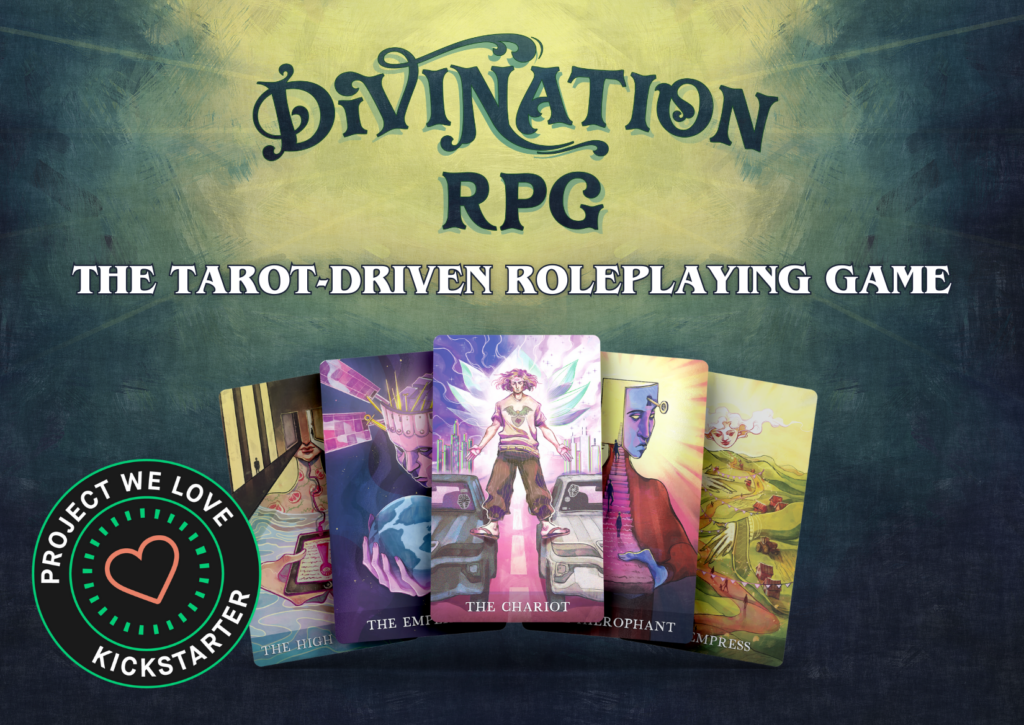
Don’t just consult the cards, adventurers! Support the Divination RPG Kickstarter!
What initially drew you to incorporating tarot into an RPG experience?
I’ve always used tarot as a part of my TTRPG ventures, I think. It’s been an idea generator, a generator for NPC motivations—a set of huge, abstract symbols from which to draw. So as I ran D&D games growing up, and later, World of Darkness games, I liked to use tarot to get ideas about plots, motivations, antagonists, worlds of magic, all kinds of stuff. I got my first Pixie (RWS) deck in my teenage years, and started running games for my friends right around the same time.
Matthew Muñiz
Were there influences other than tarot that served as inspiration for the game’s mechanics?
I loved the World of Darkness games from the 90s, and grew up on Basic and Advanced D&D—a childhood inheritance from my erstwhile-nerd parents. I liked how WoD games let you develop your character without levels (I recall that as revolutionary once upon a time, way back when). Those worlds also aspired to delve into the psychology involved in role-playing and character development. I think of those games as blazing a trail that now lots of other narrative-first games follow.
Some of those, like Bluebeard’s Bride and Kids on Bikes, use shared hero and shared character dynamics that really influenced Divination as well. As roleplaying games explore GM-lessness, elements of shared storytelling are becoming increasingly common, and I think those mechanics work beautifully in Divination because it’s based on tarot. Tarot is so much about introspection and personal growth, and so a game where the parts of the mind negotiate that (and sometimes fight over it) suits our world really well.
Matthew Muñiz

Can you walk us through the core mechanics of Divination RPG?
There are two main mechanics that make up the heart and soul of playing Divination. One is the shared Hero that Matthew mentioned, and the second is the performance of Tests.
You play Divination as one Aspect of a Hero, and your fellow players are also Aspects of that same Hero. Each Aspect embodies one set of drives and desires inside that person, which adds an additional element to roleplay. Sometimes one Aspect is in Control of the Hero and is navigating the world and dealing with NPCs just like any other roleplaying game, but at other times we zoom in to the internal and see the conversations happening between the Aspects—the Hero’s internal thoughts and conflicts and questions playing out live. Each player has an Aspect sheet which tracks the stats and abilities unique to them as an individual, and collectively the players share a Hero sheet which tracks the stats available equally to all of them.
Where all those different stats and abilities come in brings us to the other core mechanic of Divination: the Test. This is essentially your skill check, but it’s resolved by drawing a tarot card instead of rolling a d20. We use one portion of the tarot deck that contains numbered cards only, and draw a card to get a numerical result (after applying modifiers to reflect difficulty, stats, and Powers, of course). The number gives a clear success or failure, but the scene depicted on the card and the meaning of the card is rolled into the how of that success or failure as well.
Tests can be Active when the Hero is proactively acting on the world, or Passive when they need to respond to the forces of the world acting upon them.
Nyx Tesseract
How do you envision the concepts in Divination RPG fitting into the broader world of tabletop RPGs?
One of the things I’m personally most excited about is the way Divination handles the Hero’s experience of being hurt both physically and emotionally. We’ve separated this experience into Injury, which happens to the body, and Harm, which happens to the mind or the psyche. I don’t want to spoil too much of what you can discover playing the game, but I think we offer the opportunity for players to explore a lot of nuance in what it means to be hurt. This is something we’re really excited about offering to the gaming community at large, because I don’t think either of us has seen it handled or delved in quite this way before.
And I mean, it’s so tarot. It’s so tarot to explore every element of our human experience, the good and the bad, through a lens of non-judgmental curiosity.
Nyx Tesseract
How does interpreting the cards impact the gameplay and decision-making process for players?
The beautiful thing about Divination is that it’s both numeric, which means it can do the things that dice can do, and it’s pictorial, which means it speaks in the fuzzy, flexible language of pictures. When a Test is read, it does more than just tell the players whether or not they were successful at whatever they were trying to do—it can also suggest why. This almost always amounts to thoughts and feelings that influence the moment, but a Diviner is invited to weave the meanings they read in the cards into the story in any way that inspires them. This makes for emotional, profound moments where everyone is surprised by what they discover in the cards. I know we keep saying this, but it’s so tarot.
Matthew Muñiz
What challenges did you encounter while designing a system that incorporates both numerical crunch and interpretation of tarot cards?
It’s challenging to offer people permission to interpret tarot cards. People think they have to memorize long lists of meanings, but in my opinion, all you have to do is look at a picture and allow it to make you feel something. In Divination, we divide the tarot deck into smaller decks to make it easy to do this. The mechanical crunch is fairly easy, with +1s and -1s like other games.
You really just have to trust that you’ll look at a picture and seize the opportunity to be creative with what you see—or give yourself permission to skip that part when you want! You don’t have to interpret any moment that doesn’t make sense to you. A joy of Divination is allowing a symbol to persist and coming to understand what it means later.
Matthew Muñiz

Besides tarot’s role in the mechanics, how does tarot exist in the world and society of the game?
Tarot is baked into every part of our setting, which imagines two worlds: the Apparent and the Esoteric. The Apparent is the mundane world we all inhabit, and the Esoteric is the one populated by Artists—modern wizards who use the tarot and their unique connections to the Art to pursue their agendas.
These Artists each walk a Road that dictates what their connection to the Art is like. There are seven Roads in total, and each is wildly different. In Divination, you’ll make a single Hero on a single Road, so you get incredible replayability from our game as you explore all seven Roads. Each Hero on an Esoteric journey will be a part of a rich world full of competing agendas and surprises, all drawn from tarot.
Matthew Muñiz
What has been the community’s response to Divination RPG so far?
We’ve been just blown away by the way Divination seems to really touch every single person that touches it. I think the shared Hero is a huge part of that, and particularly the way the game builds that Hero. Our character creation process isn’t something you do at home before you show up to play; it’s almost a game in and of itself as the players are led through a series of story prompts (guided by tarot cards, of course) to tell formative stories about their Hero’s life. It acts as kind of an icebreaker, but in practice it becomes so much more than that. We run a lot of games at conventions and events where you regularly have four strangers come together for a game, and we’re always blown away by how naturally the game fosters investment and trust as the players build their Hero together. It’s pretty magical.
Nyx Tesseract
Are there any plans for future expansions or other content related to the game?
The core book—the Divination RPG Guidebook as we’re calling it—is going to be really complete in terms of running and playing the game. But as Matthew mentioned earlier, there are these seven different Esoteric Roads to explore, and I think that’s the most likely place for some expansion. The core book will include setting information for each Road, but eventually we’d like to create a full campaign module for each one as well, complete with NPCs, antagonists and threats, and even an outline of story beats and options. Currently we’ve got a full module like that for one of the seven Roads, but that’s a place we’d love to continue exploring and even bringing in outside writers to create more of those modules.
Nyx Tesseract
What is one of the most creative things you’ve seen players or Diviners do with Divination RPG?
I think you could pose this question to our Discord community and get dozens of stories, so I’ll just share one very recent one that brings me so much joy. One of our Discord members ran across an event called “Capybara Week” where a gaming group was looking for GMs to run any system with a capybara theme. Our community member signed up to run a Divination game with the following pitch: “Four aspects of the mind of someone find themselves awakened one day inside the body of a capybara, by a twist of fate. Together, they will navigate this new life on the shores of the lagoon, deciding whether to adapt or seek a way back to who they once were.”
Nyx Tesseract

Obsidian Portal Campaign of the Month March 2024: Wrath of the Highborn
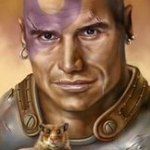
You search the lands for treasures and find them within the Obsidian Portal, in a land called Beregond. Like a glittering, magical jewel, one campaign shines brightly — it is “Wrath of the Highborn” by Keryth987! Within its many facets, you behold lands many decades in the making, fantastical stories written by a true entertainer, animated visuals and videos, and some surprises… is that a Klingon Bat’leth? Step forward into the not-quite-forgotten realms of this multi-award-winning GM to find out how he did it and how you can improve your own campaigns…

- Congratulations on your third, winning campaign! We know from your previous interviews that you’ve been playing since 1991 and have been using Obsidian Portal for almost a decade and a half, now. What changes in the world of gaming have you seen in that time which have had the greatest impact on you and your group?
First off, thanks. It’s nice to see what is a Labor of Love for me to get acknowledgement. Regarding changes in the world of gaming, I’d have to say the presence of computers and technology, along with the growing popularity of TTRPGs in general. When my group began playing it was 2nd Ed D&d and everything was pen and paper with dice, some miniatures, and a GM screen. Now everyone has a laptop or pad at their seat, with Obsidian Portal and D&D Beyond open as we play 5e for the current game (Other non-D&D Campaigns well, no Beyond being used of course). It’s also been nice to see gaming go from a fringe hobby to the popular activity it is now.

- The Chronicle section of “Wrath of the Highborn” details the journey of your players with some very excellent writing, from a simple village meeting to epic battles with dragons and demons. Can you give us a brief synopsis of the campaign, so far?
Well, this campaign actually comes out of my previous D&D Campaign, “A Rising Darkness.” In that campaign, the group of PC’s ended up needing to free a powerful elven sorceress to obtain something they needed to stop the Big Bad. That sorceress helped them in turn by also eliminating one of the lieutenants of the campaigns Big Bad, who just so happened to be the Elven Queen who had exiled her in the first place. She then went on to take over the city her rival once ruled and began building an army and playing conqueror, all while sending those she dubbed Her Chosen (and provided with a means of automatic resurrection should they die) with recovering some powerful magic relics called The Jewels of Aelis. The current party, through discovery, divine messengers, and prophecy, learned of this and have taken up the cause of defeating The Highborne Queen, recovering The Jewels of Aelis before she does, and destroying them.
The campaign began with them escorting the daughter of a prominent merchant from Goldshire, along the Sword Coast, across the Trackless sea, to Maztica, where they journeyed to Fort Flame. It was about the time of their arrival in Maztica, that they learned of the Jewels and The Highborne Queen’s goals. Since then the group has been following what evidence they have gathered as to where the various Jewels are, recovering them, and trying to find a way to destroy them, all while dodging The Highborne Queen’s Chosen, as well as some other enemies they have made along the way. As of the writing of this, they are off in Kara Tur, trying to infiltrate the Monastery of the Black Moon, to recover the last of the Jewels that have not already been recovered by either them or The Highborne Queen.
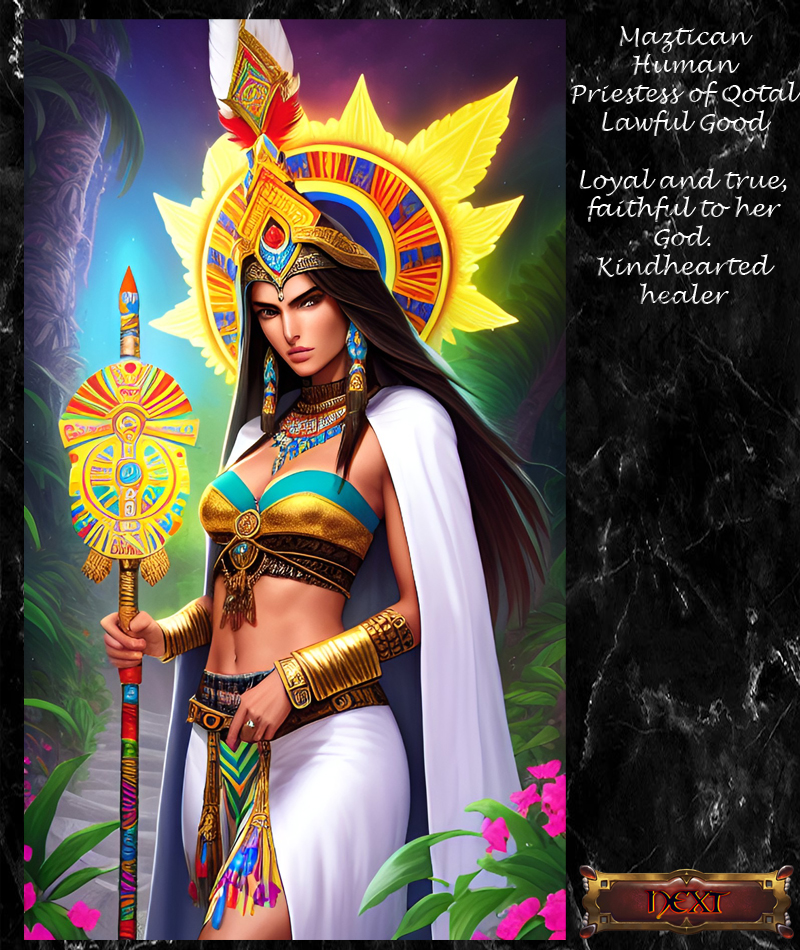
- “Wrath of the Highborn” is set in Beregond — a world adapted and expanded from Forgotten Realms material — and is also part of a shared set of worlds called “Chornalth” which are written and organized by other GM’s. Are there any challenges or advantages when dealing with interconnected planets and stories managed by other game masters?
Not really. We’ve been sharing “Chornalth” now for some time (The other two worlds being Liga – a heavily modified Oerth/Greyhawk Adventures, and Krynn – a highly modified Dragonlance world with some Dark Sun and others thrown in). Everyone in our group is pretty good at separating player knowledge form character knowledge, so when there is crossover, we are usually able to confer well and still not ruin the RP and sense of wonder while ensuring no one steps on another GM’s toes or messes something up in the other GM’s world. It also is a nice thing to have the shared world, as the last campaign on Liga (a Pathfinder Campaign) and actions taken by those PCs were what was utilized by the Big Bad of “A Rising Darkness,” to release his evil Over-Deity from his prison, which the events of, in turn, provided the villain for Wrath of the Highborne. It’s fun being able to play in one’s own sandbox sometimes as well, so, having the crossover ability allows that to happen both character wise as well as lore and interaction.
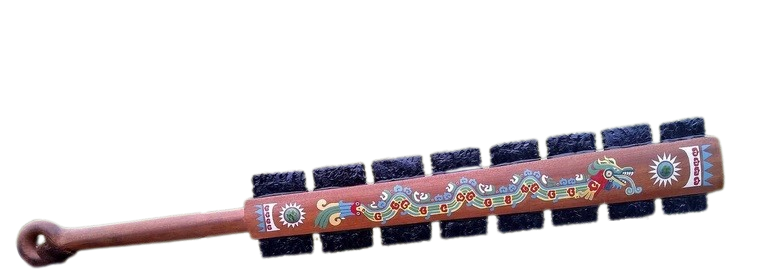
- Decades of work have gone into Beregond and it shows — one of your previous winning campaigns was set in the same world. Is “Wrath” connected in any way to the previous stories of “A Rising Darkness” or are your players treading on entirely new territory?
Well, as mentioned previously, the villain of “Wrath,” The Highborne Queen herself, was a sort of ally of the PCs in Rising, and two of the PC’s in “Wrath” – Shalryssia Peshlakai and Vimesh Damocles, are related to two PC’s from “Rising” – Sylmara Skystriker and Vito Damocles respectively. However, the party has covered far more territory than in past campaigns as they’ve also adventured outside of my modified Faerun, venturing to the continents of Maztica and Kara Tur, and even up into Selune’s Tears via spelljammer.
- Your site visuals are always outstanding and you’ve been incorporating video and audio components with your games for some time now. For GM’s who want to emulate those same techniques, what advice would you give or what digital tools and resources would you recommend?
Well, the videos are made using Wondershare Filmora, and the music is usually edited as needed in Audigy. I’m rather proud of the two videos for “Wrath,” both the Teaser on the Main page as well as the Introduction/Opening Credits that is listed as the Prologue for each Book on the site). As for the artwork, lots of Photoshop work, and, I have to admit some AI tools for base images. – Specifically Dream by Wombo. I know many frown on AI art, but were I to rely on my art skills, everything would be stick figures and such. The AI lets me take my ideas and those of my players and turn them into images that can be used, though not a single on has not been manipulated via photoshop, whether it’s to create and entirely new image such as the campaign background (there are, according to the folder on my PC, 20 separate images utilized in that), creating the many Book Covers (angain 8-10 base images to produce the various components and then Photoshop to put the elements all together), to modifying the skin colors and eyes of images so Night Elves and Genasi and Half Drow match the player’s vision of their character. It also lets us let our characters not only be “This character looks like Alessandra Ambrosio as a Maztican Priestess of Qotal” as a text or vocal description, but actually be able to see the character’s physical appearance.
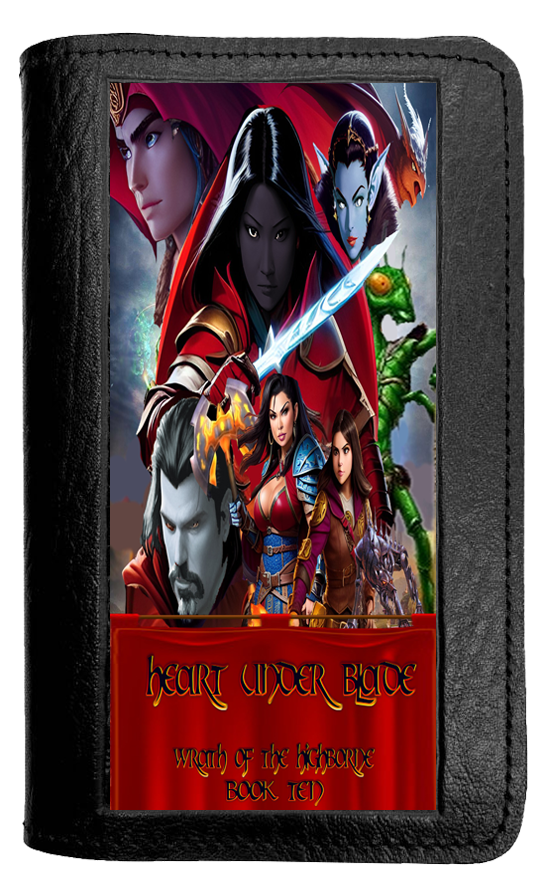
- You have extensive experience with lots of different gaming systems — story-driven like Dresden Files, more rules-focused like D&D, and everything in between. In your opinion, is the game system critical to the success of a campaign or is it just a personal preference?
To be honest, the system isn’t as important to a campaign’s success as much as those involved in playing it – both GM and Players. My group’s been blessed for many years to have had plenty of great players and storytellers. Some have since moved on from the gaming table either due to Real Life commitments or moving out of the area, and others have joined the group to take their place, but in a gaming group that meets regularly every week and has done so since the 90s, we’ve only had to ask 2 people to leave the group due to issues. The heart of any successful campaign is not the setting or the system, but the people playing the game.
- You don’t shy away from mixing and matching elements from different settings to get the kind of game you want, like bringing in a race from a futuristic TV series or movie into a fantasy game like “Wrath.” Have you ever run into any unexpected problems when introducing something like this? Is there a lot of prep-work involved to make it all fit together or can you just make adjustments after enough years of GM experience?
Well, in “Wrath,” adding in Mass Effect’s Asari was a bit of a challenge…but eventually I found a way to make it work based on the lore I’d created for Beregond and “Chornalth” in general. Others, the idea of how to bring them in just came to me suddenly. And some, like the Draenei and Night Eves of World of Warcraft, well, they were simply a modification of their origins as provided in their original source material. To be honest, the biggest problem caused by this would be a toss up between trying to figure out how to make Klingon weapons work stat-wise, or finding a location to place the Tharks of Barsoom. Seeing as how every race that has been added has been because I wanted said race available, it’s not been too much trouble. And now, with resources like OP and Beyond, it’s even easier as I am able to find resources for these already available to use rules wise.

- Without giving too much away to your players, can you give us any hints about the future direction of “Wrath of the Highborn?”
Well, as mentioned they are working on retrieving the final Jewel that they know has not already been recovered. This is forcing them to infiltrate the Monastery of the Order of the Black Moon, a group of Shar worshiping Shadow Monks in Kara Tur (and something that came completely out of the background of one of the PCs, Koumori Shojo). This will bring the group into conflict with the Order’s Master Monk, as well as his followers and probably some Priests of Shar as well, After that, the players have indicated to me that they want to deal with the Red Wizard of Thay that once possessed one of the Jewels and that they have come into conflict with, as well as eliminating the remaining of The Highborne Queen’s Chosen. They also have a side quest for the Sha’ir Warlock in the group, Vimesh , to finish, as well as recovering the remaining Jewels from The Highborne Queen (which might cause them to destroy her). And then, finally, they need to discover the location of The Hall of Bones, to destroy the Jewels.
- Any plans for future campaigns that you would like to disclose? Or are you looking forward to a break while someone else runs the next game?
Well, I always am working on new campaign ideas. I have at least three concepts I’m tinkering with on OP now. But, the current plan is to resume our Savage Worlds campaign that was put on hold, then after that it looks like we might be playing a Planescape campaign, and one of the other players is hinting he is ready to start running the sequel to his last Pathfinder campaign. Honestly, the fact that pretty much everyone at the table is capable of and enjoys being a GM, is one of the reasons our group has lasted this long (the other being strong bonds of friendship). So, it looks like it will be a bit of time before I’m behind the screen again after this.

- Finally, Obsidian Portal readers are always hunting for helpful hints on how to better run their own games or build their sites. Do you have any particular tips or tricks that you would like to share?
Well, Obsidian Portal has been a godsend for me, enabling me to organize my thoughts and concepts and get them down somewhere solid, as well as to keep track of previous events in campaigns. As for developing sites themselves, Wolfhound’s tutorials over on his “Dresden Files Dallas” site are still a good place to start, as are the Obsidian Portal forums. However, the biggest help for me has been the Obsidian Portal Discord Server, where I have repeatedly gone for help and assistance on how to take an idea and make it work Textile/CSS wise (I’m looking at you Nuadaria and Abersade and others) and i highly recommend anyone interested in using Obsidian Portal go there, socialize, bring up their questions, and share their creations.
Alas, adventurer, our journey into Beregond is brief and too swiftly ended. With thanks to Keryth and his players, we turn our sights to other realms and future jewels of wondrous writing, clever coding, and delightful design. Do you know of a campaign worthy of notice? Perhaps your own, even. If so, send us word on the Community Forums or the Obsidian Portal Discord so that we may share the creativity of our gaming greats with everyone. Until next month, traveler!
Thank you to the community for making this campaign of the month possible! That’s all for now, join us on our next adventure April 1st, and don’t forget to nominate your favorite campaigns for our next Campaign of the Month!
Obsidian Portal Campaign of the Month January 2024: More Things in Heaven and Earth

Get ready to jump into the mystical techno-magical future of North America after “the Awakening”. The year is 2082. The place is “The Emerald City”, where people are willing to risk it all and walk on the bleeding edge, making deals with anything. The GM is Dropbeartots. The runners are a rag-tag group of humans, an elf, an ork and a troll. They adventure in a Sixth World Shadowrun game called More Things in Heaven and Earth.
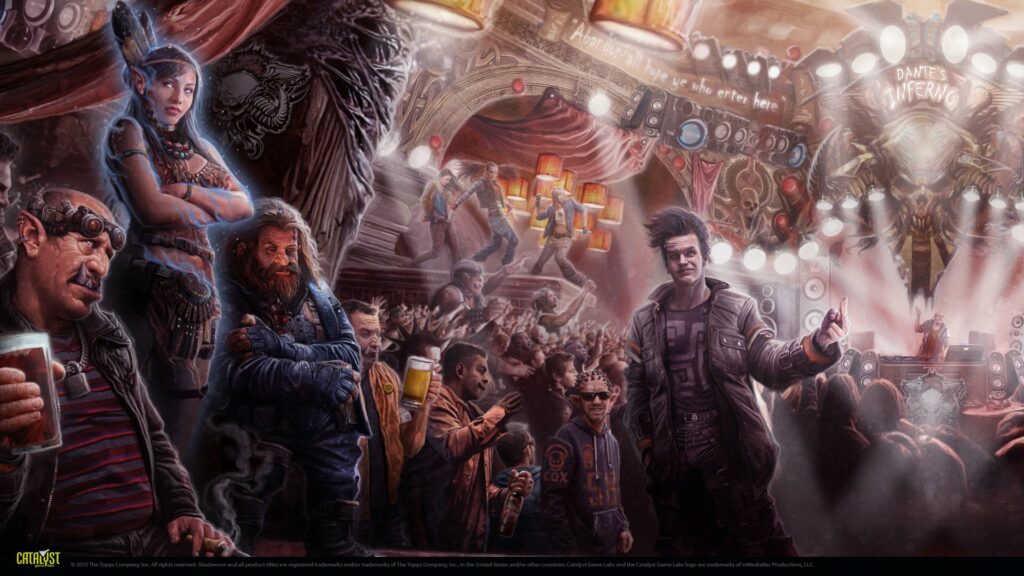
First off, feel free to tell us about the person behind the GM screen. Where are you from? What do you do aside from gaming? Alter Egos? Life partners? Family? Where can we interact with you on the internet?
I’m just an Immortal elf hanging around waiting to see the Awakening happen still! My alter-ego is a dropbear, of course. My folks were military, so I really didn’t settle down anywhere for very long until my Dad retired. Since then, Ive been in Texas. Aside from gaming, I work a lot and try to make enough money to keep up with Shadowrun’s new releases and increase my collection of older edition books. Two of the gamers in my group are related to me: Ringpop is my wife, and Nomad is my youngest son. My internet activity has decreased quite a bit in the past few years, but I have a neglected site on WordPress called When Dropbears Attack! I really should get back into it…

You are running a Shadowrun Sixth World Game. Are you familiar with the previous editions and if so, can you mention any differences, or talk about the evolution of the Game? What are the things you most enjoy about the Shadowrun world in general?
Shadowrun has been the single game that’s really carried my interest across all editions. I’ve been the forever GM with it since first edition came out! The most captivating thing for me about it has been the evolution of the story of the Sixth World across the decades, and the back cover blurb of the first edition core rulebook just grabbed me more than any other game ever has. It has always been a game about three worlds – Man, Magic & Machine – that kept me engrossed the most as a reader, player, and game master. I keep coming back to it time and again even when I get distracted with my interests in a wide variety of other games. When most people can point to D&D as their definitive TTRPG starting point, I can honestly say that yeah I started with it but I never really loved gaming as much as when Shadowrun was first plopped down in front of me.
Sixth World, for me, has a plethora of good points. In the first five editions, the skill lists were pretty extensive. As a skill-based game, on the surface this always seemed appropriate. But this often seemed to me to cause characters to have a lot of spread-out skills distributed at a low level just to cover all of their bases. With Sixth World, the skill list has been very condensed, and I have found that a lot of my long-time players are happier with building characters.
Another good point to me is the Edge system. As a sort of advantage mini-game, it has encouraged a lot of thought by the players into roleplaying seeking out various environmental and situational advantages
in their exchanges, both in combat and social encounters. I will admit to it being a lot of work to keeping up, but I think if used and taken advantage of, the system offers a lot to players.
Mechanically at its heart, SR has always been a d6 based dice pool system. Since 4th edition, the target of rolling has changed from a sliding scale Target Number that varied wildly to 5 or 6 being a “hit” and the more hits you collect the better off you are at whatever you want to be doing. I think that’s great, as it puts less mathematical work into the rolling part of the game. Although I personally never had a problem with doing the math (and never had any issues with THACO, either!), more people seem to be into less math with their math rocks, so it meets that desire well.
I‘m well aware of a lot of the editorial and mechanical issues with Sixth World. I think the recently released corrected Seattle and Berlin city editions of the core rulebook have done a fantastic job of correcting a lot of errata and injected pieces that were missing with the original core rulebook. Also, the Sixth World Companion offers up a lot of optional rules to flavor your game to taste. Overall, I find Sixth World to be superior in every way to the previous 5th edition of Shadowrun.
As I’m sure most fans of Shadowrun will agree, the biggest draw to the game for me is the game world itself. From the 2050s to the 2080s, the game‘s writers have built up a backdrop of shadowy intrigue, corporate espionage and betrayal, magical wonders, ancient mysteries working their way into a postmodern cyberpunk world, and moved that world through some strange, weird, off-the-wall and sometimes downright head-scratching moments. In the end, it’s largely what you make of it at the table as a group though. And I personally have the most fun with it over all other games.
As far as my thoughts on the most complete, most well-written, and well-tested edition of Shadowrun? I would have to say I’m mixed on that. I find both 3rd and 4th edition to be the ones that grabbed me the hardest of all. I’d put Mike Mulvihill, Rob Boyle, and Adam Jury on my list of those who produced my overall favorite stuff for Shadowrun. Why don’t I stick with those editions instead, you might ask? Hrm, have you seen the prices people are asking for some of those out-of-print books? Can you say “collector gouging”? 😉
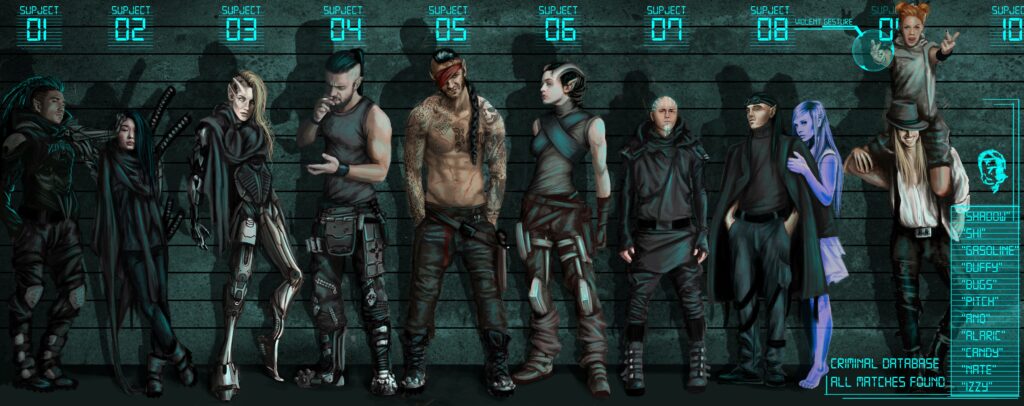
How did your group meet up? How often do you play? What are your sessions like?
I have known Bowynn, Krysa’s player and Kwaba, Robot Jones’ player, for an exceedingly long time, I think it’s going on thirty years now. We’ve played SR since Third Edition. It seems like I have known Nomad’s player all of his life 😉 It’s sorta my fault he got into gaming, after all. Twitch and Little Doll’s players, I met through my wife. She met them on the Amtguard field, and introduced them to me and we tried out gaming with D&D for a while, then i finally had to start them playing Shadowrun. I seduced my wife into the dark side of Shadowrun shortly after we met, and I think that she fell in love with the game just as much as she did with me, lol.
We have been playing weekly together for a while now, with game night settling on Tuesdays. My wife and I have been travelling a lot for her job as an RN, so there’s been a lot of play through voice calls on Messenger for a while. Since I recently settled into a new job a few months ago, I’ve been more localized to our house and our in-person gaming has resumed.
Our sessions can usually be boiled down to one word, lol. Chaotic! If you know, you know…
You have a very innovative Navigation System on your site. What inspired you? How did you go about setting it up? What advice can you give for new GMs on Obsidian Portal who want to do the same?
Really, I have to give a lot of props to the site’s design here. It gives the opportunity for Ascendent
members to edit, add, remove, and modify the navbar to their heart’s content if they wish. And I speak only for myself here, but it is a GREAT feature that I was super enthusiastic about when it came up.
I was particularly intrigued by the way you extended your Experience Point Awards to cover three different sections – Heat, Reputation and Karma. I know you also had this on your previous award-winning site, “Wildside”, but what inspired this, and in what way does it help you and your players?
Karma is the real “experience point” value among the three here, although all three are earned by characters in Shadowrun through play. Reputation is how well-known a character becomes among other groups of the world by their actions in-game – its not always positive, either! And Heat measures how much characters have screwed up and both how well-known among and how wanted by the authorities a Shadowrunner has become. The lower the better there 😉
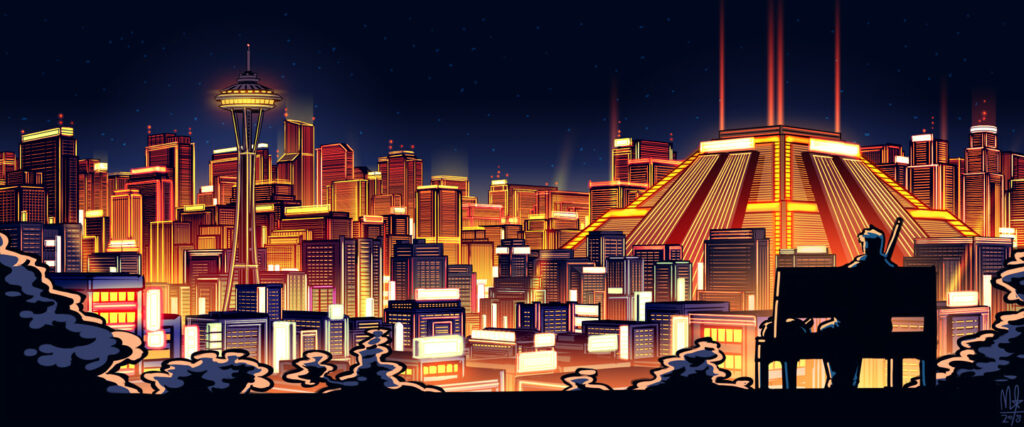
Your “Critters” section is very cool. Which ones have been the most memorable in your game so far? And DO tell us more about the “Drop Bear”…
A lot of the threats a character will run into are human in Shadowrun, but there are other… things out there as well. In Shadowrun, these critters are normal animals that have changed somewhat due to the influx of magical energy into the Sixth World over the seventy-some-odd years of the alternate history. I wanted to build a section for my players to be able to see some of these things and reference rumor of their various capabilities. Most of the time, I add to the critter section before one is potentially encountered.
Well, the Drop Bear is kind of exactly what is described in the Critters section. An awakened koala with very sharp teeth and claws that fall off of trees to drop on their unsuspecting prey – which often tend to be humans! The group has managed to find one of these critters well outside of its native habitat that was subjected to a variety of experimentation in a corporate lab. Ringpop, the resident animal lover, has ended up sort of adopting it and is trying hard to tame it and teach it tricks. She named it Tater Tot. She gets a lot of static from the rest of group because of that…
How involved are your players in the site? Who tends to do what? Do your players add their own Adventure Logs?
The player of Little Doll, the group’s social butterfly and face, tends to post the bigger updates on the Adventure Logs from her character’s perspective about all of the goings-on. When other players are able, they have added to the Adventure Logs as well.
I tend to use the site as a whole as a reference and tracker for our game, and the Adventure Logs to post contacts reaching out to various members of the group to set up jobs, or to frame events that occur in the world that are outside of the characters’ spheres of influence but might affect them in some way.

How long have you been using Obsidian Portal? What brought you to the site and what keeps bringing you back?
I have been using OP since 2009. I had been looking for a campaign journal site, and I really enjoyed the features OP offered a lot. What keeps me there is the fact that they are so devoted to continually improving the experience of use and site utility, and the community built up around the site that is so supportive among the users.
If you had to pick just one thing, what would you say Obsidian Portal helps you with the most?
I would say that Obsidian Portal is awesome for giving me the means to keep my campaigns’ details
organized, cataloged, and documented. And it allows me to customize so much of the way I would like to do that.
What would you say is the biggest highlight of your game so far (please also provide images and links if possible)?
Little Doll and Nomad say that Tater Tot (https://morethingsinheavenandearth.obsidianportal.com/characters/drop-bear) is the highlight of the game 😀
Ringpop says it was the time her character got stuck in Dante’s Inferno and was singled out by Dion (https://morethingsinheavenandearth.obsidianportal.com/characters/dion), the lead singer of Thursus (https://morethingsinheavenandearth.obsidianportal.com/characters/thursos), for romantic overtures only to find out that he is actually a dragon! She ran so fast… Ringpop does not like dragons at all, they make her very nervous and she already has a difficult time in social environments.

Okay, as a last question, we always ask for the GM’s “pearls of wisdom”. What GM insights can you offer the community this month?
In Shadowrun especially, if you can set up paranoia, do it! Use what the players tell you about their perceptions of what’s going on to feed the flames. Don’t always confirm what they say, but do confirm enough to make them feel what they are thinking is right before you introduce a twist and pull their rugs out from under them.
Always keep pressure on the characters, keep them hungry, use external organizations to push them and show them the sharks swimming alongside them, and give them enough rope to hang themselves.
Be sure to reward them well when they pull off something ingenious, give their characters’ actions, relationships, and personal motivations weight, and make them matter in the world at large.
And last, but, not least, if they decide to take on an MCT Zero-Zone, go hard. Make them work.

Thank you to the community for making this campaign of the month possible! That’s all for now, join us on our next adventure February 1st, and don’t forget to nominate your favorite campaigns for our next Campaign of the Month!
Creator Spotlight | An Interview with The Furtive Goblin and The Lawful Neutral (Bridgetown)
In the realm of tabletop roleplaying games, few settings capture the unique blend of pastoral charm and liminal unease as effectively as Bridgetown from Technical Grimoire. This never-ending, ever-crumbling bridge straddling the boundaries between realms has become a popular destination for adventurers seeking a taste of the extraordinary.
Behind the imaginative tapestry of Bridgetown lies a team of creative minds who have poured their passion and expertise into crafting this enchanting world. We had the privilege of interviewing the Lead Writers of Bridgetown – The Furtive Goblin and The Lawful Neutral (John Gregory) – to delve into their inspirations, design philosophies, and hopes for the future of Bridgetown.
In this interview, we’ll explore the genesis of Bridgetown, the unique challenges of designing a setting that defies conventional boundaries, and the team’s vision for the game’s future. Prepare to embark on a journey through the ever-shifting landscapes of Bridgetown, where the ordinary meets the extraordinary, and the boundaries between worlds are as fluid as the river that flows beneath the ever-present bridge.
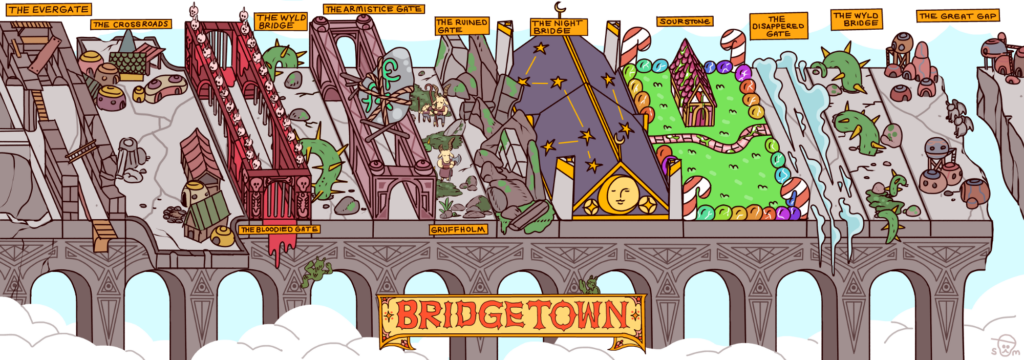
What makes Bridgetown different from other TTRPGs?
Bridgetown is a campaign setting for Troika! which seeks to exchange its default gonzo science-fantasy flavor for something different. It’s a game set in an impossible location–a never-ending Bridge–that is caught somewhere in between rustic folklore, Boschian fever dream, and dystopian punk, with a little sprinkle of hobo culture for good measure.
The Furtive Goblin
Bridgetown is a setting and resource book that goes along with the very inspiring Troika! system, which itself was inspired by old school Fighting Fantasy. Troika! overall has done an amazing job at inspiring weird and psychedelic settings that range from science-fantasy to cottagecore to genres I’ve not even got a name for. Bridgetown itself is what we’re calling a Liminal Pastoral setting–somewhere between wandering across Ghibli landscapes, living on Old London Bridge, and being stuck in The Backrooms. It is a weird world caught between infinities on every side, yet it is homey.
The Lawful Neutral
What are some of the challenges you faced while designing Bridgetown?
We (TLN and I) had a lot of ideas to start off. We spent almost an entire week just doing an idea jam while looking up images of old medieval bridges. Way too many ideas to fit into a single product and still get away with calling it a zine. We had to hone our focus to be more narrow and bridge-like. Fortunately, our team was way better at making us do that than we were at first.
The Furtive Goblin
Really, once Furtive Goblin and I got onto the Bridgetown writing train, the main challenge was knowing when to stop. We came to David/Technical Grimoire with pages and pages of ideas for what was originally going to be a little twenty page zine. With the help of David giving us reasonable restrictions and Hannah, our editor, taming our writing, we were able to go from a complete mess of materials to an actual functional Bridge(town.) That all said, another part that we considered a design challenge was “How do we make a setting interesting that is literally only 50 people wide East/West and infinite North/South?” We thought that it could feel constricting or railroad-y, but our playtesters really felt like the space restrictions actually made for interesting challenges and gave them a good impetus for continuing to journey onward.
The Lawful Neutral
How did you playtest Bridgetown?
TLN and I took a hands-off approach to playtesting, and let David run several games with playtesters that he organized. This ensured there was little to no influence from us as the writers on how the players interpreted the text. It also led David to make some really fun and interesting calls as a referee that helped shape how the rest of Bridgetown was written, alongside all the player feedback we received.
The Furtive Goblin
Our playtesting was done by a combination of several very fun sessions run by David as well as a pair of live plays on Twitch! Instead of personally running or playing in it ourselves, Furtive Goblin and I listened in on the sessions and paid attention to what did and didn’t work, what folks were excited about, and where we could tweak parts to be more clear. One of the major changes to come out of it was the original fundamental premise. We had planned for folks to be playing a character that is ultimately looking for a place to settle down and make their Home, allowing the character to retire and someone new from the location to adventure from there. However our playtesters had so much fun with their initial characters that they simply wished to keep on journeying!
The Lawful Neutral
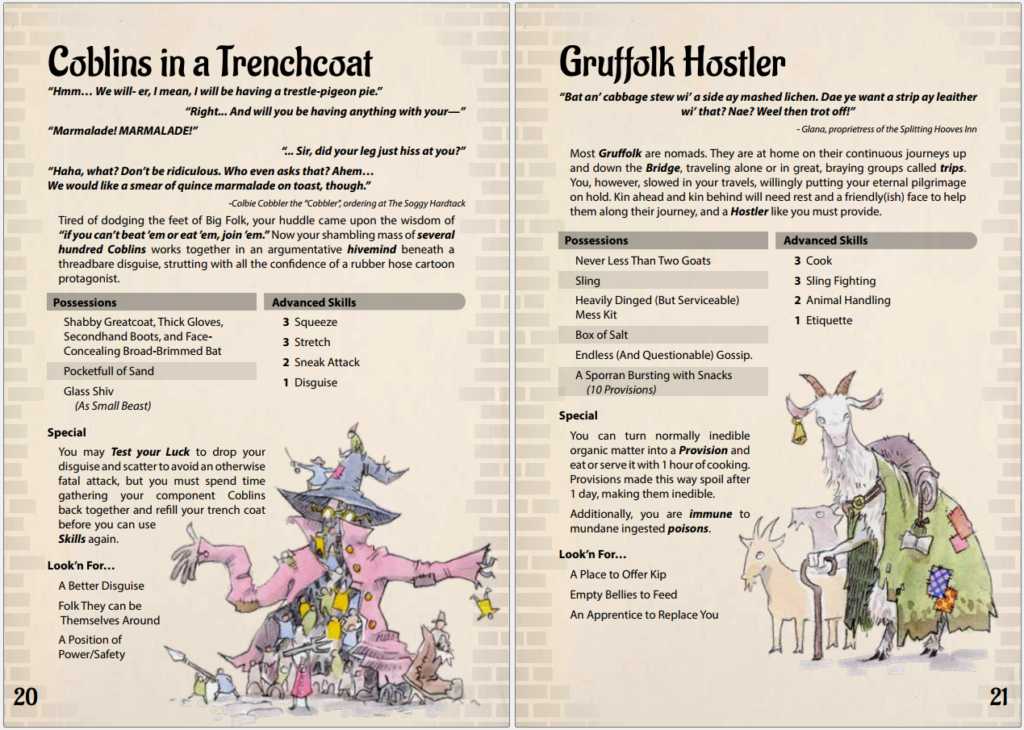
What are some of your favorite features of Bridgetown?
The “Weather” table including flocks of awful birds dropping feces like a hailstorm is definitely a crowning achievement of Bridgetown, and gaming in general. In seriousness though, I love that we managed to build a sort of natural ecology into the Bridge, with all the critters and weirdos that entails. The book has some of my favorite backgrounds in all of Troika! Ghost hivemind golems (Stone Keenings) and Brummie-accented sewer trolls are pretty high up there.
The Furtive Goblin
The certainly colorful locations and NPCs, many of whom are inspired by our own personal game experiences. Each span and district of the Bridge has its own unique flavor which we hope is inspiring to anyone who decides to walk it. You could take pretty much any setting or genre, mix it with a little weird, and set it down onto the Bridge. And if you ever get tired of it, all you have to do is jump off the side and see what strange new world you land in!
The Lawful Neutral
What are your hopes for the future of Bridgetown?
I can realistically see us working on Bridgetown for a few more years, whether it’s in the form of adventures or fun new ideas for backgrounds and locations. One early idea we put on hold was designing a Bridge generator that you can use to create randomized districts filled with events, landmarks, etc. on the fly. We went with individually crafted locations instead, and I think that was vital to nailing the themes and atmosphere of Bridgetown. But I still think that generator would be the perfect capstone for the IP, as a way of giving it over to the players once we’ve said our piece. As endless as the Bridge is, I don’t think we’ll be churning out endless amounts of content. It needs to be allowed to breathe.
The Furtive Goblin
Furtive Goblin and I are still writing more and more for it and we think it would be great fun to have expansion zines come out for it over time. I’d personally love to hear from folks about any sessions they run and how they put their own unique spins on it. One of the ideas we were not able to fit fully into the book but we encourage people to consider– each of the infinitely tall Piles/Pillars that the Bridge sits on could be hollowed out to throw any dungeon you might want in there. We might get out something in the near future giving some fun examples for this.
The Lawful Neutral
Can you talk about the pastoral and liminal aspects of Bridgetown?
“Pastoral” as a concept is a huge beast that encompasses thousands of years of literature, poetry, and music, but for Bridgetown we used it in the sense of the idealization of the rustic and the rural; the shepherd wandering with their flock. It kind of takes a sarcastic or ironic bent here, because the Bridge is anything but cozy and rural. It is literally liminal, in that a bridge is a thing meant to connect two locations that don’t exist in this scenario. But it’s also liminal in the sense of a lack of belonging. It’s a game of punks and wanderers looking for something that their tiny sliver of infinity didn’t provide them.
The Furtive Goblin
Take the story of the Billy Goats Gruff. On one side there are the barren hills from which our three Goats come from and on the other are the heavenly Fat Pastures that they wish to reach. In between there is a bridge and a troll. This is an idealized pastoral landscape that the Billy Goats live in, but the story takes place on a bridge–a liminal place that is neither here nor there, it is the place in between here and there. In Bridgetown, the Bridge is all there is. The Bridge and the promise of the Fat Pastures. It is where the hope of a rural but uncomplicate life is shadowed by this strange, unforgiving landscape where people of all walks survive the best they can. There is probably some sort of allegory for Purgatory in there if someone wanted to run with that.
The Lawful Neutral
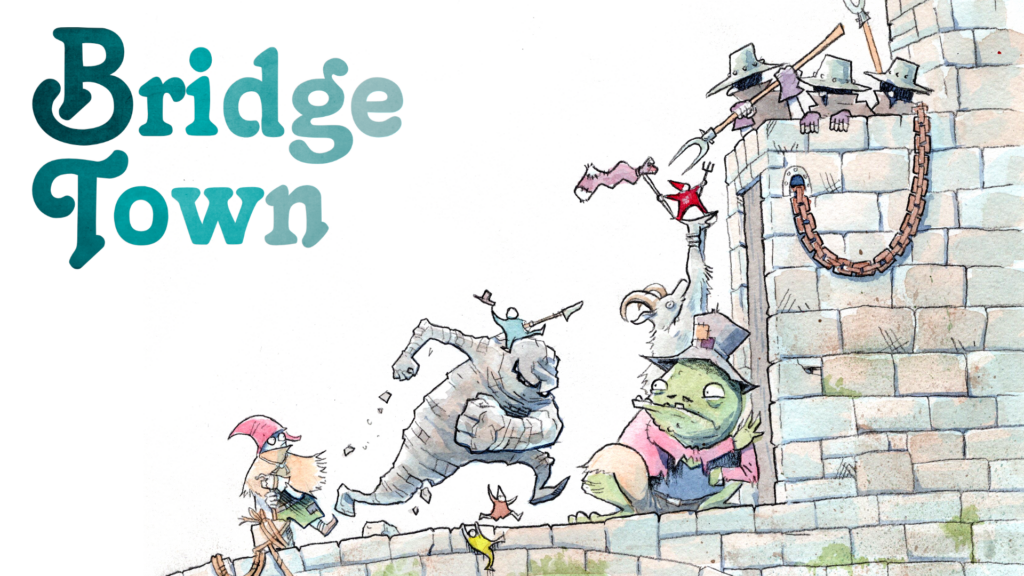
How does the provisions-based economy work in Bridgetown?
Food-as-money is one of many ways business can be conducted on the Bridge. Commerce inside a neighborhood is as simple as hashing out agreements and giving gifts between people you’ve known your whole life, but anywhere else on the Bridge you’re a stranger whose word is only as good as the goods and skills you possess. And no matter where you go, everybody needs to eat (except maybe Stone Keenings). So provisions are an obvious and practical medium for trade, with the added bonus of not having to deal with turnpike guilds.
The Furtive Goblin
When your world has a 50-man wide boundary, you have to make due as much as possible with the space and resources you have for there is scarcity everywhere. The Tower Aristocrats and the Turnpike Guild try to impose local currencies–but these are more or less like the script that mining companies imposed, useless outside of their immediately controlled areas. And so the name of inter-district trade is all about bartering. Iron from the Cable Mines traded for produce from The Squeeze, artifacts pulled up from The Great Excavation traded for clean water sourced from the Wyld Bridge. Among the motley folks who call the Bridge home, needs often outweigh wants so a loaf of good gitless bread can get you a long way.
The Lawful Neutral
What are some examples of Keystone Spells and Troll-Croak magic?
The magic wielded by Stonewrights–basically stonemason wizards–pulls latent energy out of the Bridge and the stone that constitutes it. Thus they require magical keystones to power their spells. Do this too recklessly, and the Bridge begins to erode and fall apart around you. A perfect example of this is Stone to Soil, which turns rock into dirt- ideally for gardening, but nefarious uses exist too. Troll magic comes from the gut, so to speak. Their spells cost Stamina like in classic Troika!, and reflect the ancient shamanic traditions of the sewer trolls. An example is Inoculate, which renders someone immune to a single disease- handy to have when you spend so much time in sewer water.
The Furtive Goblin
So the biggest differences between the two types of magic here is who uses it. Stonewrights are, by and large, humans who use the energy of the Bridge itself to cast their magics–they bend and manipulate the natural forces of the bridge to their whims. This is why some are Bolsterers, who work to maintain a balance and preserve the Bridge, and some are Eroders, who siphon magic from the Bridge without thought of consequence. When a human dies, their soul is often interred into Keystones to preserve the magical energy of the Bridge itself. A very basic Stonewright spell is Word on the Street, where they essentially commune with the Bridge itself for the local gossip. Trolls, on the other hand, are connected body and soul to the Bridge without the need of Keystones–when they pass away they turn back to the stone from which they were born. Thus, their magic comes from within, allowing their croaking songs channel the Bridge through them directly. A very direct example is Yaulp, which takes the echoing nature of the Bridge’s sewers and amplifies it into a concussive shout that can be heard a mile away.
The Lawful Neutral
What are some of the weirdest birds and weather events in Bridgetown?
Scrapper Herons are four-eyed nightmares with serrated beaks that can rip through metal. You don’t want to be well-armed when one of those starts building a nest. You can’t get much weirder than Under-Things on the Bridge. The Under is a soup of cloudy, rarified reality that the Bridge sits on top of, and once in a while it belches forth Things made out of roiling matter and concept. They’re childlike and curious about the Bridge, which is bad news when their mere presence can kill you or drive you batty. My favorite is the Slavering Under-Thing that understands through taste, and leaves a lot of scandalized Bridgers in its wake.
The Furtive Goblin
My favorite bird is Bosch’s Echo-Babbler, a massive bird hiding in its thick shell and using it to crush unwary targets then slurp them up with an elephantine hummingbird tongue–but that’s the beauty of the Awful Birds. Look at some Bosch or some Zdzisław Beksiński then combine it with a bird and you’ve got yourself an Awful Bird for any scenario. The Weather on the Bridge is more like “Whether” whether we’re going to have rain or a few hundred mouse-sized Coblins paragliding down to stab and steal. While the table of Spells run amok is really absolutely fun, my personal favorite Weather is this: “Scent of Home: A wind blows, carrying with it a smell somehow both unfamiliar and nostalgic, a sweet promise of new beginnings and old dreams fulfilled. A wind like this blew the day you left home.”
The Lawful Neutral

Can you tell us more about the Stone Soup Campaign?
Despite being an introductory quest, Stone Soup was one of the last things we added during development. It’s more TLN’s baby than mine, which makes sense since he’s already worked on at least one other food RPG, Gourmet Street. Stone Soup is essentially a road trip where your map is a list of esoteric recipes and abstract ingredients for the bizarre stuff you can cook up using this totally-not-horribly-cursed cauldron with a magical keystone embedded in it.
The Furtive Goblin
Stone soup arose out of a need to tie everything together and give folks a sort of impetus for travel if they didn’t already have one. There is nothing like giving folks a powerful, strange, non-completely-understood magical item from day one and telling them to run with it. It also encourages folks to look around at everything they encounter in Bridgetown, consider what might be an ingredient, what might hold deeper metaphysical meaning/power. A major inspiration for what counted as ingredients in Stone Soup came from Gleipnir, the rope that binds Fenrir. The Breath of Fish, the sound of a Cat’s footfall, the roots of mountains etc.So those mushrooms that the Troll Sewer Working is carrying is an ingredient, but so too could be the secret name of the Undercrone or the passed along memory of the taste of the Candy-Cobbled Streets.
The Lawful Neutral
What do you think makes Bridgetown a good TTRPG for one-shots?
The Bridge is divided up into locations and gatehouses that each offer a unique feel and plenty of fuel for referees. You could blow through a whole town or a dungeon in a single session this way, if you want them to be bit-sized. You can also build the Bridge “tall” and put way more emphasis on a single place for multiple sessions. Or you could get so absorbed in a single event or NPC that that spirals out into an unexpected emergent story that then dominates the entire session, as our playtesters managed to do a few times!
The Furtive Goblin
Bridgetown is not only great for one shots because our awesome publisher literally made a free One Shot generating resource on his website, but the very distinctive flavor of each district makes it very easy to move from set piece to set piece without significant travel times or lead up normally involved in a large campaign. In the playtests we were generally able to get through three to four districts in a single session–but at the same time there is enough happening in each district that one could spend multiple sessions in a single one if the referee and the players feel so inclined.
The Lawful Neutral
What advice would you give to someone who is new to Bridgetown?
Embrace that feeling of being a drifter who rolls into town and shakes everything up a little. Give yourself over to whimsy, and see where your feet wind up taking you. It’s an endless world out there, and one place is just as good as the next.
The Furtive Goblin
Have fun with it and go with the flow. Bridgetown isn’t necessarily about a specific victory condition, it isn’t necessarily about defeating monsters or gaining treasure. Bridgetown is about enjoying the journey and living the world, it is about trolls who want fair working conditions and nomadic goatfolk for whom life is an eternal pilgrimage. It is about tiny boschian goblin-things who alternately want to stab big folks and live comfortably inside their walls. It is about being a ten foot tall rock monster who wants, more than anything else, to find a place to truly rest. In short, it is the same advice I’d give to any player–play the world.
The Lawful Neutral
What’s the most creative thing you’ve seen a player or GM do with Bridgetown?
Early on in the playtest, our Stone Keening character effectively no-selled a potentially very hairy encounter by absorbing an angry, out-of-control magical experiment into itself, giving the spirits the experiment was made out of a chance to cool down in a safe space. It also had the side benefit of righteously pissing off the mad doctor who was behind it.
The Furtive Goblin
In one of my favorite playtests a group of Coblins and a Stone Keening worked together to bind, rejuvenate and give a sort of metaphysical birth to long lost souls using their combined connections with the Bridge and interactions with a particular strange stone you’ll find in Craterton. But that is only one of a dozen such stories I could tell about how we’ve seen players take our basic prompts and turn them into so so much more.
The Lawful Neutral
What might fans look forward to in the future from you?
More Bridgetown! It might take a while to get a sequel/extension book squared away, but the team plans to have another Bridgetown book out sometime next year. We left way too many neat ideas on the cutting room floor not to. As for me personally, I am mostly focusing on my blog and the occasional book contribution or playtest.
The Furtive Goblin
I am right now between books so I’m largely self producing mini generator zines for folks to have fun with. Magical Miscreants, a Witch/Wizard generator, and Gobs Galore, a goblin generator, are my latest ones on Itch. However, Furtive Goblin and I hope to produce more Bridgetown content with Technical Grimore in 2024 as well as getting our greedy writing fingers into some more projects. Keep an eye out!
The Lawful Neutral
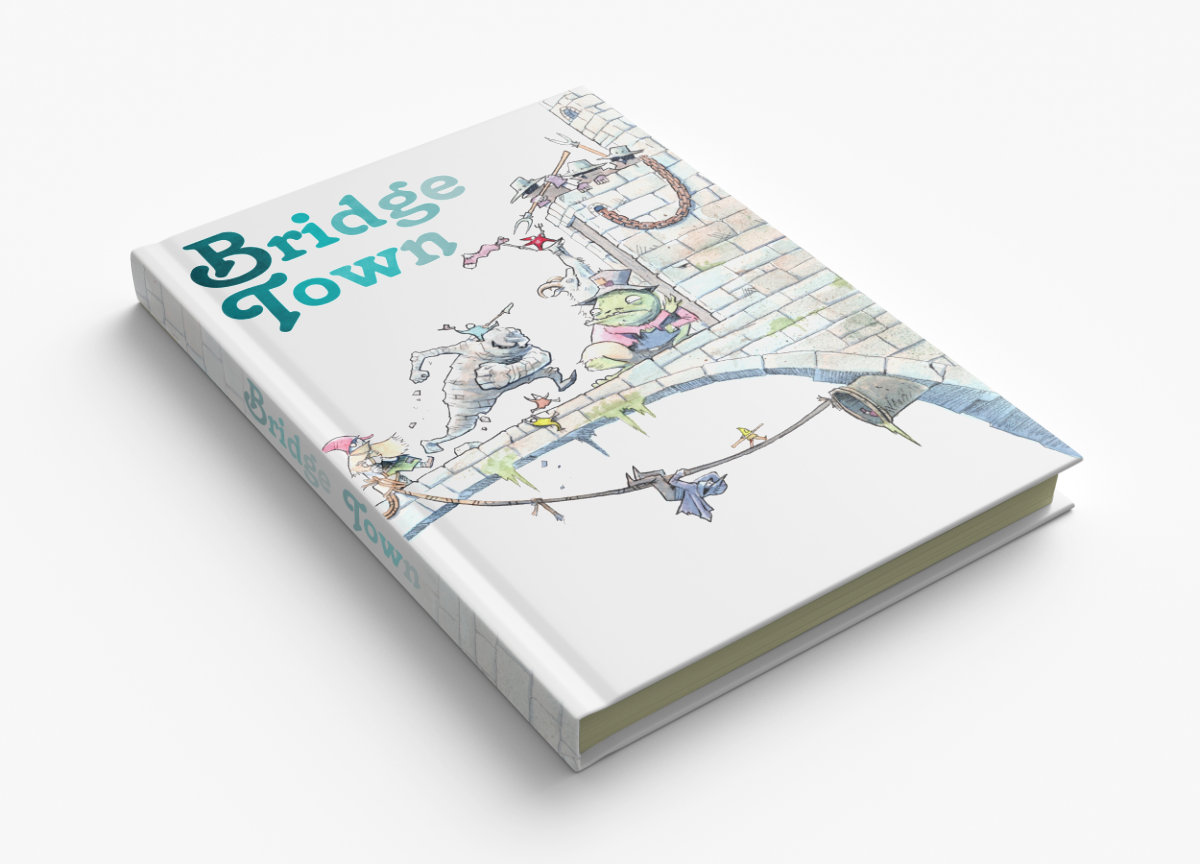
You can find more about Technical Grimoire on their website, Twitter, Facebook, Instagram, or Discord. The Furtive Goblin and The Lawful Neutral can both be found on Twitter.

